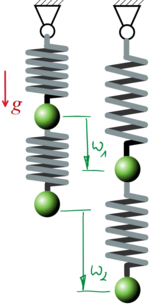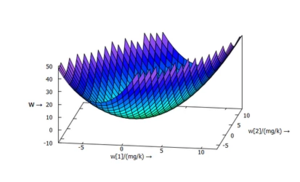Gelöste Aufgaben/FEAC: Unterschied zwischen den Versionen
Keine Bearbeitungszusammenfassung |
Keine Bearbeitungszusammenfassung |
||
| Zeile 67: | Zeile 67: | ||
bzw. in Matrixform | bzw. in Matrixform | ||
::<math>[\underline{\underline{A}}=k \begin{pmatrix} 2 & -1\ | ::<math>[\underline{\underline{A}}=k \begin{pmatrix} 2 & -1\\ -1 & 1\end{pmatrix},\underline{b}= m\cdot g \begin{pmatrix}1\\ 1\end{pmatrix}]</math> | ||
mit der Lösung (vgl. Minimum Prinzipe) | mit der Lösung (vgl. [[Sources/Lexikon/Minimum Prinzipe|Minimum Prinzipe]]) | ||
::<math>\displaystyle [{{w}_{1}}=\frac{2\cdot g\cdot m}{k},{{w}_{2}}=\frac{3\cdot g\cdot m}{k}]</math>. | ::<math>\displaystyle [{{w}_{1}}=\frac{2\cdot g\cdot m}{k},{{w}_{2}}=\frac{3\cdot g\cdot m}{k}]</math>. | ||
| Zeile 89: | Zeile 89: | ||
</syntaxhighlight> | </syntaxhighlight> | ||
}} | }} | ||
<!-------------------------------------------------------------------------------->{{MyCodeBlock|title=Post-Procesing | <!-------------------------------------------------------------------------------->{{MyCodeBlock|title=Post-Procesing | ||
Version vom 23. Februar 2021, 15:03 Uhr
Aufgabenstellung
Hier berechnen wir die analytische Lösung zur Aufgabe FEAA.

Gesucht ist die analytische Lösung für die statische Auslenkung der beiden Massen. Wir arbeiten dabei mit dem Prinzip vom Minimum der Potentiellen Energie.
Lösung mit Maxima
Header

Als Koordinaten führen wir die Auslenkungen der Massen aus Ihrer Referenzlage ein, in der Referenzlage sind die Federn entspannt.
/*******************************************************/
/* MAXIMA script */
/* version: wxMaxima 15.08.2 */
/* author: Andreas Baumgart */
/* last updated: 2017-09-14 */
/* ref: FEM, PVMPE using two coordinates */
/* description: solve by principle of minimum of p. E. */
/*******************************************************/
Equlibrium Conditions
Das Potential für das Aufstellen der Gleichgewichtsbeziehung lautet
- ,
wobei
/* Potential Energy of system (equilibrium condition) */
parts : [/* work of gravitationaö forces */
A = m*g*w[1]+m*g*w[2],
/* strain energy*/
Pi = 1/2*k*w[1]^2 + 1/2*k*(w[2]-w[1])^2];
PMPE : U= Pi-A;
PMPE : subst(parts,PMPE);
Solving
Die Gleichgewichtsbeziehungen nach dem Prinzips vom Minimum der Potentiellen Energie
- .
liefern die Gleichungen
- .
bzw. in Matrixform
mit der Lösung (vgl. Minimum Prinzipe)
- .
/* pick individual equations */
equs : makelist(diff(subst(PMPE, -U),w[i])=0,i,1,2);
coord: makelist(w[i],i,1,2);
/* compose augmented coefficient matrix */
ACM : augcoefmatrix(equs,coord);
/* ordinary lineary system of equations*/
ole : [A = submatrix(ACM,3), b = -col(ACM,3)];
/* -> here we employ the shortcut via "solve" */
sol: solve(equs,coord)[1];
Post-Procesing

Das dimensionslose-gemachte Potential U ist hier über w1 und w2 aufgetragen: man erkennt das Minimum des Potentials bei der berechneten Lösung.
/* plot results */
pltfct : expand(subst(makelist(w[i] = m*g/k*W[i],i,1,2),subst(parts, subst(PMPE,U/(m^2*g^2/k)))));
plot3d(pltfct,
[W[1],2-10,2+10], [W[2],3-10,3+10],
[z,-10,50], [legend, "potential energy"],
[xlabel, "w[1]/(mg/k) →"], [ylabel, "w[2]/(mg/k) →"], [zlabel, "U →"]);
Links
- ...
Literature
- ...